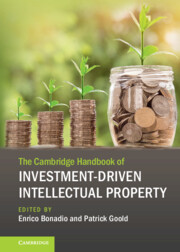Book contents
- The Cambridge Handbook of Investment-Driven Intellectual Property
- The Cambridge Handbook of Investment-Driven Intellectual Property
- Copyright page
- Contents
- Figures and Tables
- Contributors
- Foreword
- Introduction
- I Creativity, Pluralism, and Fictitious Narratives
- Part I Science, Technology and Industry
- II Sui Generis Protection of Non-creative Databases
- III Test Data Exclusivity
- IV Copyright in Works Created by Artificial Intelligence
- V Plant Variety Protection and Investment
- VI Software Protection under Copyright Law
- VII Bilski and the Information Age a Decade Later
- VIII Pharmaceutical Patents and Evergreening
- Part II Culture and Entertainment
- Part III Signs, Images and Designs
VII - Bilski and the Information Age a Decade Later
from Part I - Science, Technology and Industry
Published online by Cambridge University Press: 16 March 2023
- The Cambridge Handbook of Investment-Driven Intellectual Property
- The Cambridge Handbook of Investment-Driven Intellectual Property
- Copyright page
- Contents
- Figures and Tables
- Contributors
- Foreword
- Introduction
- I Creativity, Pluralism, and Fictitious Narratives
- Part I Science, Technology and Industry
- II Sui Generis Protection of Non-creative Databases
- III Test Data Exclusivity
- IV Copyright in Works Created by Artificial Intelligence
- V Plant Variety Protection and Investment
- VI Software Protection under Copyright Law
- VII Bilski and the Information Age a Decade Later
- VIII Pharmaceutical Patents and Evergreening
- Part II Culture and Entertainment
- Part III Signs, Images and Designs
Summary
About two decades ago the Federal Circuit threw open the doors of the US Patent Office to business method patent applicants. State Street announced that methods that yield a useful, concrete, and tangible result would be eligible for patent protection.1 This decision roughly coincided with the birth of e-commerce and an explosion of business method patents in the USA. About a decade ago the Supreme Court stepped back from State Street by installing screens that blocked applicants from patenting business methods claimed as abstract ideas. Bilski2 characterized claims to a method of hedging against energy price fluctuation risk as abstract, and therefore not eligible for patent protection.3 All nine justices supported this result, but their opinions revealed a significant split on the question of whether any patents on business methods should be permitted. Three justices joined Justice Stevens who called for categorical exclusion of business methods from the patent system.4 Three other justices joined Justice Kennedy who praised business inventions from this new “Information Age” and fretted that overly strong screens to eligibility established during the “Industrial Age” were no longer appropriate.5 While recognizing the method at hand was claimed too abstractly to be patent eligible, these justices seemed confident that the future would bring forth many business method inventions deserving of patents.6 The ninth justice, Justice Scalia, found the middle ground; he did not join the portion of Kennedy’s opinion discussing the Information Age.7 Nor did he join Stevens by embracing a categorical exclusion of business methods.8
- Type
- Chapter
- Information
- Publisher: Cambridge University PressPrint publication year: 2023



